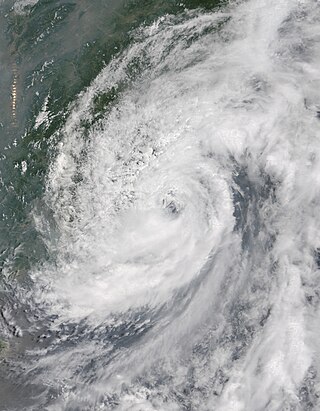
The 2002 Pacific typhoon season was a slightly above average Pacific typhoon season, producing twenty-six named storms, fifteen becoming typhoons, and eight super typhoons. It had an ACE over 400 units, making it one of the most active seasons worldwide. It was an event in the annual cycle of tropical cyclone formation, in which tropical cyclones form in the western Pacific Ocean. The season ran throughout 2002, though most tropical cyclones typically develop between May and October. The season's first named storm, Tapah, developed on January 11, while the season's last named storm, Pongsona, dissipated on December 11. The season's first typhoon, Mitag, reached typhoon status on March 1, and became the first super typhoon of the year four days later.

Typhoon Mitag, known in the Philippines as Typhoon Mina, was a strong typhoon that caused deadly flooding in the Philippines in November 2007. As the twenty-fourth named storm and the fourteenth typhoon of the 2007 Pacific typhoon season, it originated from an area of atmospheric convection south-southwest of Guam. The area of convection was in a favorable environment for development, so it organized and a low-level circulation was found inside the disturbance. Not too long after, the JMA classified it as a tropical depression. On November 20, rainbands developed along the periphery of the depression as it moved into an area of good divergence. The JMA soon upgraded the depression to a tropical storm, designating it as Mitag. A few hours later, the JTWC issued their first advisory on Mitag, and so did PAGASA, naming it Mina. The storm strengthened significantly early on November 21 and became a further intensified. Later that day, the JTWC upgraded Mitag to a typhoon, and the JMA also upgraded it late that evening. As Mitag remained stationary for a day as a Category 2-equivalent typhoon, it changed its trajectory. Nonetheless, PAGASA announced that there is still a possibility of the typhoon to once again change its course. The storm turned northwest and made landfall late on November 25. It tracked Luzon and was downgraded to a severe tropical storm before emerging back over water on November 26. It turned back to the east before reaching Taiwan, and became extratropical on November 27.

Typhoon Mitag, known in the Philippines as Typhoon Basyang, was the first super typhoon on record in the month of March. The second storm of the 2002 Pacific typhoon season, Mitag developed from a trough near the equator on February 25 near the Federated States of Micronesia (FSM). It moved westward through the archipelago and intensified into a typhoon before passing near Yap on March 2. High winds and heavy rainfall affected the state, resulting in an islandwide power outage and destroying hundreds of houses. Mitag caused severe crop damage that resulted in food shortages. The rainfall and storm surge flooded much of the coastline as well as Yap's capital, Colonia. Damage totaled $150 million, mostly from crop damage. There was one death related to the storm's aftermath.

Tropical Storm Hagibis was a tropical storm that, along with the southwest monsoon, brought heavy rainfall to the Philippines for nearly a week in June 2014. The storm formed on June 13 and dissipated on June 18. Hagibis made landfall on June 15, causing damage estimated to be US$198 million. Hagibis is a Filipino word, meaning fast or swiftness.

Typhoon Mitag, known in the Philippines as Typhoon Onyok, was a moderately strong tropical cyclone that severely affected Taiwan, East China and South Korea in early October 2019. The 23rd depression and the 8th typhoon of the 2019 Pacific typhoon season, Mitag developed from a low pressure system near the Micronesia Islands on September 24. Tracking generally northwestward, the system gradually organised and the Japanese Meteorological Agency issued its first advisory on Tropical Depression 19W on September 27. It continued northeastward, gradually organizing and becoming less broad. It was then upgraded to Tropical Storm Mitag on September 28. The storm quickly intensified, becoming a Category 1 typhoon just a day later. It further intensified into a Category 2 typhoon, passing very close to Taiwan. It weakened thereafter, making landfall near Zhoushan in East China on October 1 before weakening back to a poorly organized tropical storm. It later made landfall in South Korea on October 2 before becoming extratropical in the Japan Sea on October 3.
This page is based on this
Wikipedia article Text is available under the
CC BY-SA 4.0 license; additional terms may apply.
Images, videos and audio are available under their respective licenses.




